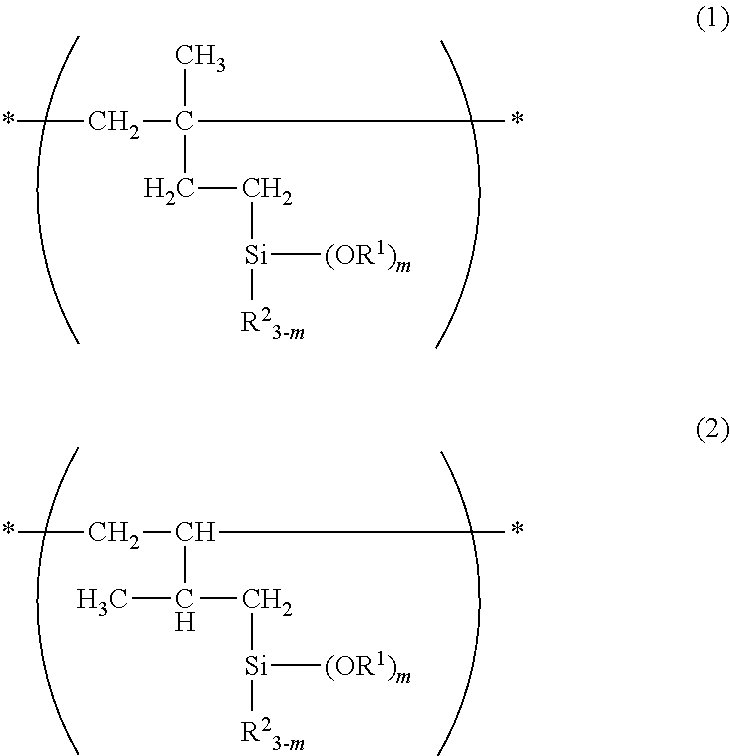Silane-modified polymer, rubber compounding ingredient, and rubber composition
- Summary
- Abstract
- Description
- Claims
- Application Information
AI Technical Summary
Benefits of technology
Problems solved by technology
Method used
Image
Examples
example 1-1
[0059]A 2-L separable flask equipped with a stirrer, reflux condenser, dropping funnel and thermometer was charged with 1,000 g of isoprene homopolymer KL-10 (Mn=10,000, by Kuraray Co., Ltd.), an amount (0.44×10−3 mol of platinum atom) of toluene solution of platinum-1,3-divinyl-1,1,3,3-tetramethyldisiloxane complex, and 0.03 g (0.44×10−3 mol) of acetic acid. At an internal temperature of 75-85° C., 72 g (0.44 mol) of triethoxysilane was added dropwise over 2 hours to the mixture, which was stirred at 80° C. for a further 1 hour. At the end of stirring, the reaction mixture was concentrated under reduced pressure and filtered, obtaining a yellow transparent liquid having a viscosity of 5,000 mPa·s and a Mn of 10,700. From the 1H-NMR spectrum and Mn, the number of constituent units having triethoxysilyl group was computed to be 3 mol % of the overall units.
example 1-2
[0060]A flask as in Example 1-1 was charged with 1,000 g of isoprene homopolymer KL-10 (Mn=10,000, by Kuraray Co., Ltd.), an amount (0.44×10−3 mol of platinum atom) of toluene solution of platinum-1,3-divinyl-1,1,3,3-tetramethyldisiloxane complex, and 0.03 g (0.44×10−3 mol) of ammonium hydrogencarbonate. At an internal temperature of 75-85° C., 72 g (0.44 mol) of triethoxysilane was added dropwise over 2 hours to the mixture, which was stirred at 80° C. for a further 1 hour. At the end of stirring, the reaction mixture was concentrated under reduced pressure and filtered, obtaining a yellow transparent liquid having a viscosity of 5,000 mPa·s and a Mn of 10,700. From the 1H-NMR spectrum and Mn, the number of constituent units having triethoxysilyl group was computed to be 3 mol % of the overall units.
example 1-3
[0061]A flask as in Example 1-1 was charged with 1,000 g of isoprene homopolymer KL-10 (Mn=10,000, by Kuraray Co., Ltd.), an amount (0.44×10−3 mol of platinum atom) of toluene solution of platinum-1,3-divinyl-1,1,3,3-tetramethyldisiloxane complex, and 0.02 g (0.44×10−3 mol) of formamide. At an internal temperature of 75-85° C., 72 g (0.44 mol) of triethoxysilane was added dropwise over 2 hours to the mixture, which was stirred at 80° C. for a further 1 hour. At the end of stirring, the reaction mixture was concentrated under reduced pressure and filtered, obtaining a yellow transparent liquid having a viscosity of 5,000 mPa·s and a Mn of 10,700. From the 1H-NMR spectrum and Mn, the number of constituent units having triethoxysilyl group was computed to be 3 mol % of the overall units.
PUM
| Property | Measurement | Unit |
|---|---|---|
| Temperature | aaaaa | aaaaa |
| Temperature | aaaaa | aaaaa |
| Fraction | aaaaa | aaaaa |
Abstract
Description
Claims
Application Information
 Login to View More
Login to View More - R&D
- Intellectual Property
- Life Sciences
- Materials
- Tech Scout
- Unparalleled Data Quality
- Higher Quality Content
- 60% Fewer Hallucinations
Browse by: Latest US Patents, China's latest patents, Technical Efficacy Thesaurus, Application Domain, Technology Topic, Popular Technical Reports.
© 2025 PatSnap. All rights reserved.Legal|Privacy policy|Modern Slavery Act Transparency Statement|Sitemap|About US| Contact US: help@patsnap.com



